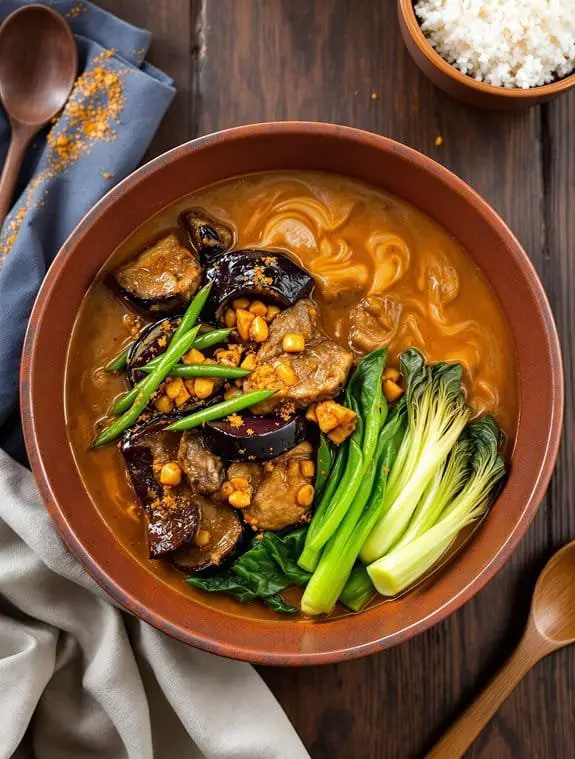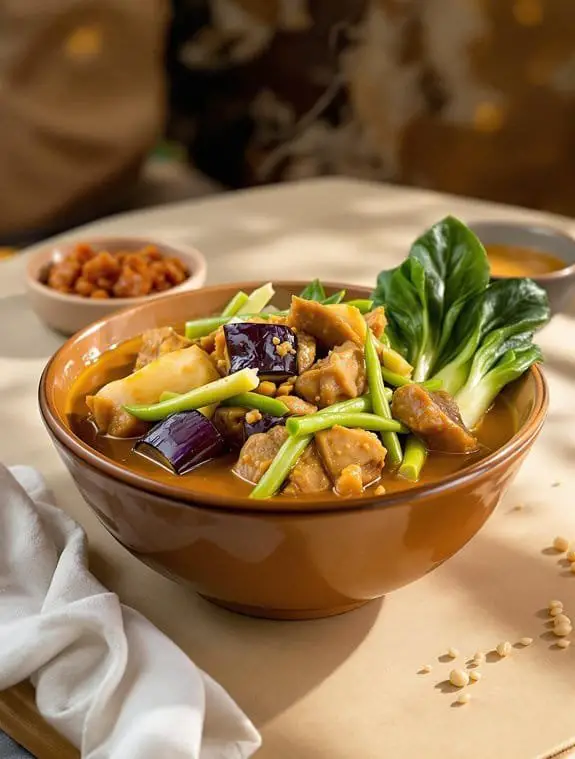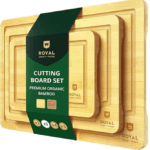Rich & Creamy Filipino Kare-Kare Recipe

I’ll be honest with you – Kare-Kare intimidated me for years. That gorgeous amber sauce, the way it clings perfectly to tender oxtail, the complex flavors that somehow taste both familiar and exotic. It seemed like one of those dishes that required some secret Filipino grandmother knowledge I’d never possess. But here’s what I discovered: this rich, peanutty masterpiece is surprisingly forgiving, and once you understand the basic technique, you’ll wonder why you waited so long to master it.
Why You’ll Love this Rich & Creamy Filipino Kare-Kare
When you take that first spoonful of kare-kare, the silky peanut sauce coats your tongue like a warm hug from your Filipino grandmother – even if you don’t have one.
This isn’t your average peanut butter situation, folks. We’re talking about a luxurious, velvety sauce that transforms humble oxtail into something spectacular.
I love how this dish tricks you into thinking it’s complicated when it’s really just patience and good ingredients doing their thing.
The annatto gives it that gorgeous amber color, while the vegetables add perfect texture contrast to all that tender, fall-off-the-bone meat.
What Ingredients are in Rich & Creamy Filipino Kare-Kare?
The beauty of kare-kare lies in its surprisingly simple ingredient list that somehow creates pure magic in a bowl. You’ve probably got half of these ingredients hiding in your pantry already, which means you’re closer to this Filipino masterpiece than you think.
Most of the heavy lifting comes from just a few star players: tender oxtail, creamy peanut butter, and that gorgeous annatto that gives kare-kare its signature golden glow. The vegetables play supporting roles beautifully, adding different textures and colors that make each bite interesting.
For the Meat:
- 2-3 lbs oxtail and/or beef shank, cut into chunks
- 1 lb ox tripe (this one’s totally optional)
- 6-12 cups water for braising
For the Aromatics:
- 1 tbsp garlic, minced
- 1-2 onions, chopped
- 2 tbsp cooking oil
For the Vegetables:
- 1-2 banana blossoms or hearts (optional but traditional)
- 5-7 long string beans, cut into pieces
- 2 Japanese eggplants, sliced
- 2-3 bunches bok choy or pechay
For the Sauce:
- 1 cup peanut butter (unsweetened works best)
- 2 tbsp annatto powder, seeds, or annatto water
- 1-2 tbsp fish sauce
- ¼ cup ground rice or rice flour (for thickening)
- Salt and black pepper to taste
Let’s talk about some of these ingredients because a few might send you on a grocery store treasure hunt. Oxtail is your best friend here – it gets incredibly tender when braised long enough and adds that rich, beefy flavor that makes kare-kare so satisfying.
If you can’t find oxtail, beef shank works just fine, though you’ll miss out on some of that gelatinous goodness.
The peanut butter situation deserves its own discussion. Please, for the love of all that’s delicious, skip the sugary stuff. Natural peanut butter or unsweetened versions will give you that clean, nutty flavor without fighting against the savory elements. Trust me on this one.
Annatto might be the trickiest ingredient to track down, but it’s worth the hunt. This little seed gives kare-kare its distinctive orange-red color and adds a subtle earthy flavor. You can find it in Hispanic or Asian markets, sometimes labeled as “achiote.”
If you’re really stuck, a tiny pinch of paprika can provide color, though it won’t taste quite the same.
The vegetables are pretty flexible, so don’t stress if you can’t find banana blossoms – they’re more about authenticity than necessity. Japanese eggplant works better than the big purple ones because it holds its shape during cooking.
And that ground rice? It’s your secret weapon for getting that glossy, thick sauce that clings to everything perfectly.
How to Make this Rich & Creamy Filipino Kare-Kare

Making kare-kare is honestly like conducting a slow, delicious orchestra where timing matters, but perfection isn’t required. Think of this as your weekend project – the kind of cooking that fills your house with amazing smells and gives you plenty of time to clean up as you go.
Start by heating 2 tablespoons of oil in your biggest, heaviest pot. You’ll thank yourself later for using something substantial because we’re about to do some serious braising. Toss in 1 tablespoon of minced garlic and 1-2 chopped onions, letting them sizzle until fragrant. There’s something deeply satisfying about this first step – it’s like announcing to your kitchen that real cooking is about to happen.
Add your 2-3 pounds of oxtail chunks (and that 1 pound of ox tripe if you’re feeling adventurous) to the pot and brown them on all sides. Don’t rush this part – you want some nice caramelization happening here. The meat doesn’t need to be perfectly browned, but a little color goes a long way toward building flavor.
Pour in 6-12 cups of water, bringing everything to a rolling boil. Here’s where patience becomes your best friend. Skim off that foam and scummy stuff that rises to the surface – it’s not pretty, but it’s totally normal. Reduce the heat and let this simmer for anywhere from 1 to 3 hours until your meat practically falls apart when you poke it with a fork.
Once your meat reaches that perfect tender state, strain everything and save that precious braising liquid. This golden elixir is basically liquid gold for your sauce, so don’t you dare pour it down the drain. Set the meat aside while you work on the next phase.
Clean your pot and heat a bit more oil for round two of sautéing. Add more chopped onion and garlic because, honestly, can you ever have too much? Add your tender meat back to the pot, then layer in those sliced Japanese eggplants and cut string beans. The 2-3 bunches of bok choy should go in last since they cook quickly and nobody wants mushy greens.
Now comes the fun part – creating that signature kare-kare sauce. Mix in 1 cup of peanut butter with some of your reserved braising liquid until smooth. This might look a little weird at first, but stick with it. Add 2 tablespoons of annatto powder (or whatever annatto form you managed to track down) and 1-2 tablespoons of fish sauce.
Gradually add more braising liquid until you reach a consistency that’s somewhere between a thick soup and a thin stew. If your sauce isn’t behaving and seems too thin, whisk in that ¼ cup of ground rice or rice flour. Keep simmering until everything looks glossy and gorgeous.
Season with salt and black pepper, tasting as you go. Kare-kare should be rich and nutty with just enough saltiness to balance all that peanut butter creaminess. The whole thing should have this beautiful golden color that makes you want to engage immediately.
Rich & Creamy Filipino Kare-Kare Substitutions and Variations
Several things about kare-kare make it incredibly forgiving when you can’t find every single ingredient at your local grocery store, which honestly happens more often than any of us would like to admit.
Can’t find oxtail? I’ll use beef short ribs or even pork hocks.
No banana blossoms? Regular cabbage works perfectly fine.
Missing annatto? A pinch of turmeric gives you that golden color, though the flavor’s different.
The peanut butter‘s your non-negotiable star, but even then, you can mix smooth with crunchy for texture.
Green beans can replace string beans, and honestly, any leafy green works instead of bok choy.
What to Serve with Rich & Creamy Filipino Kare-Kare
Perfect pairings make kare-kare shine even brighter, and honestly, you’ve got some absolutely delicious options that’ll turn this rich stew into a proper feast.
I always serve steamed jasmine rice underneath—it’s non-negotiable. The grains soak up that nutty, glossy sauce like little flavor sponges.
Bagoong shrimp paste? Essential. That salty, funky kick balances the creamy peanut richness perfectly. Don’t skip it.
Add some crispy lechon kawali or grilled bangus on the side for extra protein. Fresh lumpia works beautifully too.
For drinks, I’d go with calamansi juice or cold beer to cut through all that richness.
Final Thoughts
When you finally taste that first spoonful of homemade kare-kare, you’ll understand why this dish holds such a special place in Filipino hearts.
I’m convinced there’s something magical about the way that creamy peanut sauce coats your tongue, followed by the tender oxtail that practically falls apart.
It’s comfort food at its finest.
Sure, the recipe requires patience, but isn’t the best food usually worth waiting for?
I find myself daydreaming about that glossy, amber-colored sauce long before I even start cooking.
This isn’t just dinner – it’s edible poetry.

Filipino Kare-Kare
Ingredients
- 2 –3 lbs oxtail and/or beef shank chunks
- 1 lb ox tripe optional
- 6 –12 cups water
- 1 tbsp garlic minced
- 1 –2 onions chopped
- 2 tbsp oil
- 1 –2 banana blossoms or hearts; optional
- 5 –7 long string beans cut into 2-inch pieces
- 2 Japanese eggplants sliced
- 2 –3 bunches bok choy or pechay
- 1 cup peanut butter unsweetened, if possible
- 2 tbsp annatto powder seeds, or annatto water
- 1 –2 tbsp fish sauce
- ¼ cup ground rice or rice flour; optional
- Salt and black pepper to taste
Instructions
- In a large pot, heat oil over medium-high heat. Sauté garlic and onions until fragrant.
- Add oxtail and tripe (if using), cooking until browned on all sides.
- Add water and bring to a boil. Skim off any scum that rises to the surface.
- Reduce heat and simmer until meat is tender, approximately 1-3 hours depending on cut.
- Strain the cooking liquid and reserve the braising liquid. Set meat aside.
- In the same pot, sauté additional onion and garlic in oil until softened.
- Return the meat to the pot, then add eggplant and string beans. Cook for 5 minutes.
- Mix in peanut butter, annatto, and enough braising liquid to create a sauce consistency.
- Simmer for 10-15 minutes, stirring occasionally.
- If needed, thicken with ground rice until the sauce becomes glossy.
- Add bok choy in the last 3-5 minutes of cooking.
- Season with salt, pepper, and fish sauce to taste.
Notes
Nutrition
Frequently Asked Questions
Can I Make Kare-Kare in a Pressure Cooker or Slow Cooker?
I’ve made kare-kare in both appliances successfully. You’ll pressure cook the oxtail first to tenderize it, then finish with vegetables and peanut sauce. Slow cookers work great for the long braising process.
How Long Does Leftover Kare-Kare Last in the Refrigerator?
I’ll store leftover kare-kare in the refrigerator for up to three days. I always use airtight containers to maintain freshness. Beyond that timeframe, I’d freeze it for longer storage or discard it for food safety.
Why Is My Kare-Kare Sauce Not Thick Enough?
Your kare-kare sauce isn’t thick enough because you didn’t add ground rice or rice flour. I recommend mixing two tablespoons of rice flour with cold water, then stirring it into your simmering sauce.
Can I Freeze Kare-Kare and Reheat It Later?
I recommend freezing kare-kare without the vegetables since they’ll become mushy. I freeze the meat and sauce separately, then add fresh vegetables when I reheat it for best texture.
What’s the Difference Between Kare-Kare and Other Filipino Stews?
I’ll explain kare-kare’s uniqueness among Filipino stews. Unlike other stews that use tomatoes or tamarind, kare-kare features a rich peanut butter base with annatto, creating its signature thick, creamy texture and golden color.



